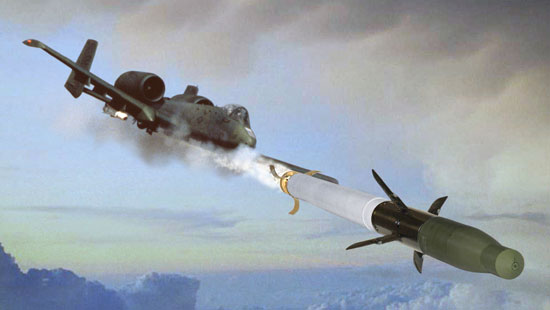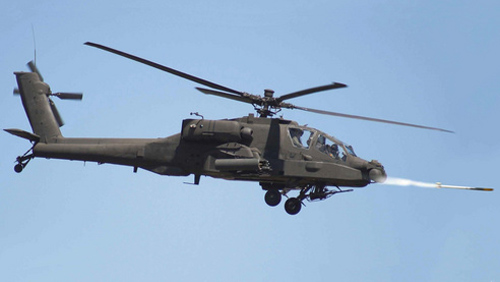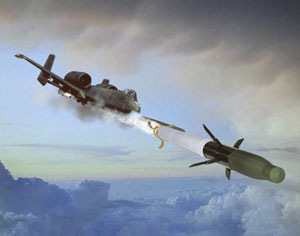
The U.S. Central Command (CENTCOM) confirmed the success of recent tests conducted with a fixed wing variant of the Advanced Precision Kill Weapons System (APKWS) laser-guided rocket. The tests were performed by the Direct & Time Sensitive Strike Weapons Program Office (PMA-242), demonstrating robust design of the and the completion of the Joint Capability Technology Demonstration (JCTD) with the U.S. Air Force, U.S. Navy, and U.S. Marine Corps. The conclusion of the JCTD is the next step toward evaluating the addition the Fixed Wing variant to the current APKWS Program of Record.
“The variety of tests helped us evaluate weapons systems build up, loading and delivery, and later, illustrate that the weapon would perform, as designed, to hit stationary and moving targets,” Bill Hammersley, the JCTD technical manager, said. “The success of these tests means that an aircraft pilot will be able to carry seven guided rockets in one launcher that weigh less than a single 500 lb. bomb, allowing for more shots in a single sortie,” added Hammersley.
“Fixed wing APKWS uses a different guidance control system to compensate for the higher altitude and longer range employments of the weapon,” Cmdr. Alex Dutko, Airborne Rockets /Pyrotechnics deputy program manager for PMA-242 explained. “The deployment mechanism had to be redesigned in order to overcome the higher aerodynamic forces of the fixed wing environment.” Guidance section tests not only demonstrated design robustness but also helped reduce risk in subsequent live-fire tests, Dutko continued. Rocket testing included ground launches and two different aerial launches, performance and MUA shots. Flight launches were tested from the A-10 Thunderbolt II, AV-8B Harrier II, and F-16 Fighting Falcon.
“These latest test results underscore the power and versatility of the APKWS technology and provide further proof that the system can be launched off of any platform capable of shooting an unguided 2.75-inch rocket,” said David Harrold, director of precision guidance solutions at BAE Systems. “Since its introduction on Marine Corps helicopters in combat operations, the APKWS rocket has proven its ability to defeat a broad range of targets. This test is an important step in bringing that same capability to fixed-wing aviators.”
During the tests held since the spring of 2013 at the Eglin Air Force Base in Florida, APKWS rockets were fired from various aircraft at different altitudes. In April BAE reported that an Air Force A-10 Warthog launched the rockets at altitudes of approximately 10,000 and 15,000 feet, at airspeeds up to 348 knots. During this test the first controlled test-vehicle shot performed a series of pre-planned maneuvers to collect in-flight data. The second shot, into a 70-knot headwind, hit the target board well within the required 2 meters of the laser spot. The shot was laser-designated from the ground with a special operations forces marker.
To date, the APKWS rocket has been qualified on the AH-1W and UH-1Y helicopters, demonstrated on the Bell 407GT, and has been flown off the OH-58D Kiowa Warrior, the Beechcraft AT-6B, AV-8B and A-10. It is expected to be similarly qualified for use on several other rotary- and fixed-wing aircraft including the AH-64D/E Apache, the armed MH-60R/S, AH-6, AV-8B, F-16, and F/A-18. BAE Systems is the prime contractor for the APKWS rocket, the only U.S. program of record delivering precision guidance for 2.75-inch rockets.
APKWS Also Cleared for AH-64D Apache
In recent weeks APKWS II has also been fired for the first time from a US Army AH-64D Apache helicopter, as part of a flight test conducted under a company initiative to obtain an Airworthiness Qualification on the helicopter, supporting future international sales. According to BAE Systems, the APKWS rocket required only eight test shots to meet the full airworthiness requirements, based on the weapon’s maturity being the U.S. military’s only guided 2.75-inch (70 millimeter) rocket program of record. During recent testing, the U.S. Army shot eight APKWS rockets from an AH-64D Apache at extreme flight configurations with airspeeds up to 150 knots and at distances of up to five kilometers from the target. The launch altitudes ranged from 300 feet to 1500 feet above ground level. Highlighting the ease of integration, which can be critical to successful deployment and weapon adoption, the APKWS rocket was installed on the Apache without modification to the platform or software.





















